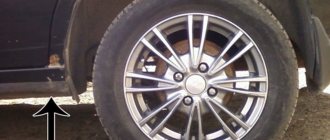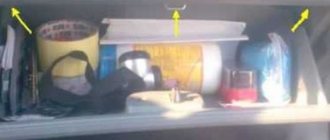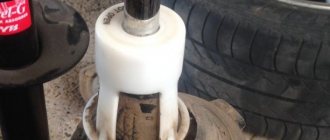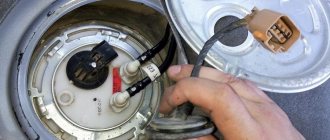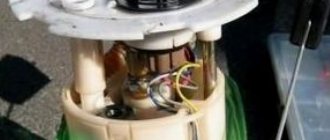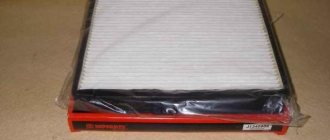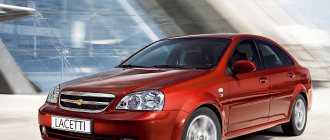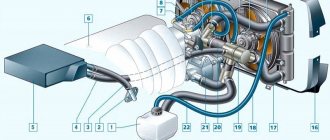Chevrolet Lacetti 1.4 MT
Chevrolet
Lacetti was produced with gasoline power units, one of which has a displacement of 1.4 liters. The engine power is 95 hp, and the maximum speed of the car is 175 km/h. Consumption with all this is 9.8 liters in the city and 5.7 liters on the highway.
Real consumption
- Anton, Ivanovo. Chevrolet Lacetti 1.4 MT 2012. I bought the newest car. I think it's worth my own money. Over the three years of operation, I only replaced the CV joint seal under warranty - it leaked in the winter, as well as the fuel tank sensor. There are simply no problems. Consumption is fully applicable - in the city 10 liters, on the highway 7 liters. The drawback is the low ground clearance; in winter, in snow and slush, the car gets stuck.
- Kirill, Moscow. I bought the car used in good condition (built in 2012). It turned out to be very reliable. It starts easily, even in winter. Due to the nature of our roads, we had to change the rear strut stabilizers. The salon is spacious. The downside is that the engine is very weak for such a car, it rarely pulls out. Hence the consumption is high - my Lacetti consumes 12 liters per hundred square meters. in the town and 8 l. on the road.
- Ilya, Kaluga. When I took it, the mileage was 88 thousand km. At the moment I have already driven 15 thousand km. The car was produced in 2007, completely undemanding with cheap and routine maintenance. Despite this cost, the interior is unusually spacious and comfortable. There is very little power in the engine, it accelerates very slowly. In this case it consumes 11-12 liters. in the town and 7 l. on the road. Poor visibility due to wide pillars.
- Leonid, Anapa. Chevrolet Lacetti 1.4 MT 2011. The car is used once a day because I work in a taxi service. Over the entire period, 230 thousand km have been accumulated. It worked for its price during the first year and never let me down. I change the oil every 10 thousand km. At 50 thousand km the explosive wires were covered. And in general, our client is happy with what remains to be done here. The only thing is that its consumption would be much lower: in the summer in the city it’s 9-9.5 liters, in the winter up to 12 liters. On the highway in some places it’s 8.5 liters.
- Sergey, Tver. Very good and reliable car. For a family of 4 people, a completely ordinary and cheap option. Stable on the highway. Despite the small dimensions, the interior turned out to be completely capacious. During this period, I only changed the wheel bearings in my own Chevrolet. Consumes within 8 liters. gasoline approximately. Build 2005.
What refueling volumes and brands of fuel and lubricants should be filled into the Chevrolet Lacetti
| Filling/lubrication point | Filling volume, liters | Name of oil/liquid |
| Fuel tank | 60 | AI-92 |
AI-95
Engine lubrication system 1.4 3.75 apI sl (Ilsac gf-III) grade sae 5w-30
(Hot zone: sae 10w-30)
1.6 3.75
1.8 3.75
2.0S DSL 6.2
Engine cooling system 1.4 7.2 Mixture of water and high-quality silicate-based antifreeze (year-round coolant)
1.6 7.2
1.8 7.5
2.0S DSL 8.0
Automatic transmission AISIN 81-40LE (1.6) 5.77 ± 0.2 esso jws 3309 or total flUId III g
ZF 4HP16 (1.8) 6.9 ± 0.2 esso lt 71141 or total atf h50235
AISIN 55-51LE (2.0S DSL) 6.94 ± 0.15
Manual transmission Petrol engines 1.8 sae80w (Extreme cold zone: sae 75w)
2.0S DSL 2.1
Brake system 0.5 DOT 3 or DOT 4
Power steering 1.1 DEXRON II-D or DEXRON III
How much and what to fill a Chevrolet Lacetti with
In accordance with the maintenance regulations, the engine oil must be changed every 15 thousand km. The procedure is performed with the engine not running immediately after the trip. It is recommended to use original oil - synthetic 5W-30. The filling volume for different engines differs - from 3.75 to 6.2 liters.
Fuel tank volume – 60 l. The manufacturer recommends refueling with unleaded gasoline with an octane rating of at least 92 or 95.
Changing the oil in the Lacetti gearbox is a mandatory procedure. After 60 - 80 thousand km, the liquid loses its properties - viscosity and so on. In regions with harsh climates, the frequency is reduced to 40–50 thousand km.
It is necessary to select transmission oil depending on the type of gearbox. For automatic use esso jws 3309 or total flUId III g, esso lt 71141 or total atf h50235, mechanical - sae80w (Extreme cold zone: sae 75w).
The brake fluid is replaced once every two years. DOT 3 or DOT 4 is suitable. Refill volume is 0.5 l.
Replacement frequency is 100 thousand km or once every three years. A mixture of water and high-quality silicate-based antifreeze (year-round coolant) is used. The filling volume directly depends on the engine type 7.2 - 8.0 liters.
Gasoline selection
According to the manufacturer's recommendation, only unleaded gasoline with an octane rating of 95 or higher should be filled into the gas tank. Fuel with a lower rating causes detonation in the power unit and can cause damage to the cylinder-piston group.
The use of low-octane fuel in the power plant causes detonation damage. They are quite easy to identify. In this case, the car owner risks losing free warranty repairs. Therefore, if you want to reduce the cost of refueling, there should be no choice between 92 or 95. The behavior of the car on various types of fuel is given in more detail in the table below.
Table - Effect of octane number on driving a Chevrolet Lacetti car
| AI-95 | Optimally suitable for Chevrolet Lacetti. Detonation occurs only during intense acceleration. |
| AI-98 | The engine on it runs most smoothly, softly and smoothly. The presence of a large number of additives leads to the formation of deposits on spark plugs. |
Technical data
The volume of the fuel tank would be a useless quantity if it were not for fuel consumption. Knowing the average fuel consumption, you can easily calculate how many kilometers a full tank of fuel will last you. On-board computers of modern cars are able to quickly show this information to the driver.
The volume of the Chevrolet Lacetti fuel tank is 60 liters.
Tank capacity Chevrolet Lacetti 2004, hatchback, 1st generation, J200
What Lacetti fluids are used?
Lacetti fuel tank
The volume of the Chevrolet Lacetti fuel tank is 60 liters. The fuel to be filled is unleaded motor gasoline with an octane rating of at least 91. It is not recommended to operate the vehicle with a minimum amount of fuel in the tank to avoid overheating of the fuel pump. Article about gasoline.
Engine cooling system and interior heating system of the Lacetti
The cooling system is filled with liquid with a freezing point no higher than -40 degrees Celsius. The fluid volume is 7.2 liters for 1.4l and 1.6l engines and 7.5 liters for a 1.8l engine. Read more about coolants and their replacement in this article.
Lacetti engine lubrication system
The oil poured into the Chevrolet Lacetti engine has a volume of 3.75 liters and is divided by viscosity, depending on the prevailing air temperature in the vehicle’s operating area:
from -15 to +50°С SAE 15W-40 from -15 to +45°С SAE 15W-30 from -20 to +40°С SAE 10W-30 from -20 to +45°С SAE 10W-40 from - 25 to +45°С SAE 0W-40 from -30 to +40°С SAE 0W-30
More information about motor oil and its replacement is written in this article.
Hydraulic brake and clutch Lacetti
The hydraulic brake and clutch drives have a common reservoir. Working brake fluid DOT-4, DOT-5 is used. The volume of liquid is 0.5 liters. Read more about replacing brake fluid in this article.
Power steering Lacetti
Working fluid DEXRON || and DEXRON |||, as well as DEXRON IV. Volume 1.1 liters. But I use DEXRON 6. Read more about that here.
Lacetti air conditioning system
The Chevrolet Lacetti air conditioning system uses R-134a refrigerant. The refrigerant weight is 640 grams. More details about this in this article.
Chevrolet Lacetti in detail about fuel consumption
The Chevrolet Lacetti first saw the light of day back in 2003. Released in South Korea, it replaced the Daewoo Nubira and, thanks to its excellent combination of price and quality, immediately showed a high sales rating. Stylish design, cheap maintenance, fuel consumption of the Chevrolet Lacetti - these and many other advantages have brought it to a leading position among other C-class cars. By the way, Italian designers did a good job on the exterior of the car, so even today it looks quite modern.
The latest cars converted to gas
Since 1996, we have installed gas equipment on 40,000 cars in service centers in Moscow and St. Petersburg. See photo of the service area
I have known about gas for a long time; moreover, I actively use it. I have a fleet of 23 Gazelles (commercial transportation), and thanks to HBO, every year I save on another one of these Gazelles. Maybe even more. The cylinders are installed at 105 liters, which is quite enough. The most important thing is to go to normal installers who will install it well and give a guarantee.
I put gas on my Ford Explorer. Briefly about the installation. The guys installed everything quickly and competently, no complaints. I took it yesterday and picked it up today with a brand new G.B.O. They installed Lovato for six cylinders, the torus cylinder and VZU were cut into the hatch. In general, we tried our best. I appreciated the benefits of gas immediately after leaving the pit. Let me start with the fact that I didn’t notice any difference at all - you switch from gasoline to gas and from gas to gasoline smoothly, there is not even a minimal transition. There is no smell in the cabin, although, having read all sorts of forums, I was most afraid of this - the smell of gas. And now about saving. I think that the fuel consumption of my car is high, and this is not always justified. If I used to drive on gasoline and spend 15 on the highway and 21.5 in the city, now it takes me 16 on the highway and 23 in the city. However, if previously it took me about 2,700 rubles per week. on fuel, now I spend a little more than one and a half thousand.
Chevrolet Lacetti engine modifications
This model is available in three body styles
:
- sedan;
- hatchback;
- station wagon;
1.6 Ecotec (petrol) 5-mech
1.8 Ecotec (petrol) 4-auto
2.0 D (diesel) 5-mech
| Engine | Consumption (city) | Consumption (highway) | Consumption (mixed cycle) |
| 1.4 Ecotec (petrol) 5-mech | 9.3 l/100 km | 5.9 l/100 km | 7.1 l/100 km |
| 9 l/100 km | 6 l/100 km | 7 l/100 km | |
| 12 l/100 km | 7 l/100 km | 9 l/100 km | |
| 7.1 l/100 km | 4.8 l/100 km | 5.7 l/100 km |
The engines are available in three versions with manual and automatic transmission.
Chevrolet Lacetti Hatchback 1.4 i 16V (94 Hp) – engine, brakes, transmission, suspension.
| Engine lubrication system | 1.4 | 3.75 | apI sl (Ilsac gf-III) grade sae 5w-30 (Hot zone: sae 10w-30) |
| 1.6 | 3.75 | ||
| 1.8 | 3.75 | ||
| 2.0S DSL | 6.2 | ||
| Engine cooling system | 1.4 | 7.2 | A mixture of water and high-quality silicate-based antifreeze (year-round coolant) |
| 1.6 | 7.2 | ||
| 1.8 | 7.5 | ||
| 2.0S DSL | 8.0 | ||
| Automatic transmission | AISIN 81-40LE (1.6) | 5.77 ± 0.2 | esso jws 3309 or total flUId III g |
| ZF 4HP16 (1.8) | 6.9 ± 0.2 | esso lt 71141 or total atf h50235 | |
| AISIN 55-51LE (2.0S DSL) | 6.94 ± 0.15 | ||
| Manual transmission | Gasoline engines | 1.8 | sae80w (Extreme cold zone: sae 75w) |
| 2.0S DSL | 2.1 | ||
| Brake system | 0,5 | DOT 3 or DOT 4 | |
| Power steering | 1,1 | DEXRON II-D or DEXRON III |
| Acceleration time (0-100 km/h) | 11.6 s |
| Fuel consumption per 100 km (city) | 9.3 l/100km |
| Fuel consumption per 100 km (highway) | 5.9 l/100km |
| Fuel consumption per 100 km (combined cycle) | 7.1 l/100km |
| Gas tank volume | 60 l |
| Vehicle curb weight | 1170 kg |
| Permissible gross weight | 1645 kg |
| Tire size | 195/55 R15 |
| Disk size | 6J x 15 |
| ENGINE (Chevrolet Lacetti Hatchback 1.4 i 16V (94 Hp)) | |
| Where is it located? | Front, transverse |
| Engine capacity | 1399 cm3 |
| Power | 94 hp |
| Number of revolutions | 6300 |
| Torque | 131/4400 n*m |
| Supply system | Distributed injection |
| Availability of turbocharging | Not included |
| Gas distribution mechanism | DOHC |
| Cylinder arrangement | Row |
| Number of cylinders | 4 |
| Cylinder diameter | 77.9 mm |
| Piston stroke | 73.4 mm |
| Compression ratio | 9.5 |
| Number of valves per cylinder | 4 |
| Recommended fuel | AI-95 |
| BRAKE SYSTEM (Chevrolet Lacetti Hatchback 1.4 i 16V (94 Hp)) | |
| Front | Ventilated disc |
| Rear | Disk |
| ABS | There is |
| STEERING (Chevrolet Lacetti Hatchback 1.4 i 16V (94 Hp)) | |
| Steering type | Rack and pinion |
| Power steering | + |
| TRANSMISSION (Chevrolet Lacetti Hatchback 1.4 i 16V (94 Hp)) | |
| Drive unit | Front |
| Number of gears (manual transmission) | 5 |
| Number of gears (automatic transmission) | Not included |
| Gear ratio of the main pair | 3.722 |
| SUSPENSION (Chevrolet Lacetti Hatchback 1.4 i 16V (94 Hp)) | |
| Front suspension | Shock absorber |
| Rear suspension | Double wishbone |
| BODY (Chevrolet Lacetti Hatchback 1.4 i 16V (94 Hp)) | |
| Body type | Hatchback |
| Number of doors | 5 |
| Number of seats | 5 |
| Machine length | 4295 mm |
| Machine width | 1725 mm |
| Machine height | 1445 mm |
| Wheelbase | 2600 mm |
| Front track | 1480 mm |
| Rear track | 1480 mm |
| Maximum trunk volume | 1045 l |
| Trunk volume is minimal | 275 l |
Photo Chevrolet Lacetti
Brake pads
| From 3100 rubles |
Fuel filter
| From 340 rubles |
Air filter
| From 950 rubles |
* all prices are approximate, check exact prices in auto parts stores
All Chevrolet Lacetti spare parts
| Type of work | Approximate cost (RUB)* |
| Change of oil | 400 |
| Replacing brake pads | 1200 |
| Chassis diagnostics | 300 |
| Replacing the timing belt | 1900 |
| Replacing spark plugs | 250 |
| Headlight adjustment | 370 |
* Prices are for labor only, excluding the cost of spare parts. All prices indicated in the table are approximate. Find out the exact prices at Chevrolet service centers.
AutoExpert recommends checking the technical condition of Chevrolet Lacetti cars twice a year (in spring and before winter), regardless of the age and current condition of the car. This will help identify problems and ultimately save you time and money. The table shows some of the work and the frequency of their implementation:
| Type of maintenance work | Frequency (thousand km) |
| Changing the engine oil and oil filter | 15000 |
| Replacing brake pads | As it wears out |
| Chassis diagnostics | 10000 |
| Replacing the timing belt | 60000 |
| Replacing spark plugs | 30000 |
| Replacing the fuel filter | 30000 |
* The maintenance intervals for the Chevrolet Lacetti model are indicated according to the manufacturer. In some cases, different maintenance intervals are possible. For detailed information, we recommend contacting Chevrolet service centers.
Modification 1.4 mt
This car is equipped with a 1.4 liter engine, the smallest volume of this line of cars. With a power of 94 horsepower, it reaches speeds of up to 175 km/h and is equipped with a five-speed manual transmission.
Fuel consumption on a Chevrolet Lacetti with a 1.4-liter engine capacity is the same for hatchback and sedan. It is 9.3 liters per 100 km for the urban cycle and 5.9 liters for the suburban cycle.
The most economical urban option pleases its owners not only with fuel consumption, but also with comfortable driving conditions.
Modification 1.6 mt
Fuel consumption on a Lacetti with a 1.6-liter engine depends on the body type. Engines of this volume are equipped with an injector and were produced until 2010. Such sedans and hatchbacks reached speeds of up to 187 km/h with a maximum power of 109 horsepower. The car was produced with a five-speed manual transmission.
The average fuel consumption of the Lacetti Hatchback in the city is 9.1 liters per 100 km,
the same figure for the sedan. But the station wagon in the same urban cycle already “reels in” 10.2 liters.
Real consumption and ways to save fuel
- Driving style
. One of the main factors influencing consumption is experience and driving skills. This is confirmed by reviews that fuel consumption on a Chevrolet Lacetti (automatic) is slightly higher than on a car of the same power, but with a manual transmission, where engine speed is controlled by an experienced driver. - It is better to refuel your car at the same proven place, because the lower the quality of gasoline, the higher its consumption.
- Low tire pressure increases fuel consumption by more than 3%, so it is important to check the condition of the wheels as often as possible and regularly inflate them.
- Movement speed. Mercedes-Benz engineers calculated the aerodynamic properties of cars and came to the conclusion that when driving at speeds over 80 km/h, fuel consumption increases sharply
. - The air conditioner and heater have a significant effect on the consumption rate. To save fuel, you should not turn on these devices unnecessarily, but it is important to remember that open windows create increased air resistance and lead to high consumption.
- Excess weight
. You should not carry unnecessary things in the trunk for a long time, which add weight to the car, since accelerating a heavy body requires more fuel. Gasoline consumption on a Chevrolet Lacetti station wagon will increase by 10-15% with a tightly packed trunk. - Also, regular visits to a service station will help keep your car in good condition and prevent unnecessary waste of fuel. This will help you appreciate the unique Chevrolet Lacetti in its class, combining beauty, efficiency and high quality.
Developments during World War II and the consequences of reorganization - 1940-1960s
Chevrolet Lacetti
World War II forced Chevrolet to reconsider its production policies. During these years, in addition to civilian cars, military vehicles, shells, and 9-mm anti-aircraft guns capable of hitting a target at a distance of up to 5 miles came off the assembly lines. In addition, Chevrolet Pratt & Whitney engines are produced, which are built into bombers. At the end of the war, the company returned to the production of pre-war cars, but with improved designs. The project to create small cars failed due to insufficient funding.
The company managed to fully recover only in 1948, when sports modifications flooded into the market. At the same time, modern pickup trucks were introduced to Americans, including Advance Design, which is still recognized as the standard of classic design. A year later, two more models appeared - Special and De Luxe. In the 1950s, you could buy a Chevrolet with an automatic transmission. The latter was also offered for other GM models.
At the same time, the talented designer Harley Earla joined the company and made a huge contribution to development. Bel Air and Corvette come from his pen. Bel Air quickly became a legend. People called it the “hot little thing” because of the installed 8-cylinder engine. At that time, the car created a sensation and was mentioned quite often in popular literature. Sales grew steadily, which made it possible to separate it into a separate series, but this happened only in 1953. The second is Corvette, also released in 1953. A special feature of the design was the use of fiberglass. A 3.8-liter engine with 152 hp was offered as standard. and two-speed automatic transmission. In 1956, the second generation was introduced with a powerful 290-horsepower engine, which was designed by Edon Wall in 1955. In 1961, power was increased to 315 hp. and the first “hundred” was achieved by the sports car in 5.5 seconds.
In 1958, the Chevrolet Impala was released, which cleverly combined the prestige and size of a Cadillac, but maintained an affordable price. On the Internet you can find pictures of a concept car with a bright green body and a dazzling white interior. During the launch of production, a powerful advertising campaign was launched, where the Impala was positioned as a luxury car accessible to everyone. In 1960, they managed to break the records of their popular predecessor and make this model a sales leader. It was the Impala that became the best-selling car of the decade.
Cars of the 50s delighted with their pretentiousness and size. The manufacturer managed to combine dynamics and modern equipment: electric windows and seats. In 1959, another pickup truck was born - the Chevrolet El Camino. The company was the leader in this segment in those years. They managed to create unique, bright pickup trucks that amaze with their graceful silhouette and provide the power of trucks. It was based on a frame structure, spring suspension and a 3-meter wheelbase. This pickup truck was the first to use a metal platform instead of a wooden one.
How many liters is the tank in a Chevrolet Lacetti: exact volume
The entire line of Chevrolet Lacetti engines is designed with an optimal ratio of efficiency and liter power. Fuel consumption is comparable to competitive models. At the same time, the car provides sufficient dynamism, allowing the car owner to feel confident both in city traffic and on the highway.
The stability of the power plant and its durability depend on the gasoline poured into the fuel tank. Therefore, the quality of fuel must be approached with maximum responsibility and not fill the gas tank with fuel from questionable gas stations.
If gasoline consumption has increased and no external factors have changed, this means that attention should be paid to the car. The consumption rate set by the automaker, although obtained under ideal conditions, is still a guideline for the normal operation of the power plant. A sharp increase in fuel consumption very often indicates that a component or part of the power plant or related systems requires repair.
What is the tank volume of the Chevrolet Lacetti?
Weight of Chevrolet Lacetti sedan
Bad gasoline leaves its mark on the operation of the engine and it soon begins to act up.
Chevrolet Cruze gas tank
That's exactly the point. Once it is mixed with water from the tank, it forms a mixture that is very similar to gasoline, it will burn like regular fuel, and without any harm to the engine. The antifreeze gets onto the exhaust manifold, evaporates and therefore the leak is invisible.
So if the driver usually drives until there is not a drop of gasoline left in the tank, then someday water will get into the gas line. A few days later the hummock started to glow again.
It’s not just Laceti, all cars with internal combustion engines behave this way. Tell me how to check a grenade on a Chevrolet Laceti, thank you very much. The combustion process occurs better in the combustion chamber.
Most likely it has been erased... please tell me how many revolutions the tachometer should show at a speed of km in a straight line in 5th gear. The question is, which Chevrolet will the doors fit on the Lacetti station wagon, broken front and rear on the right side? Tell me, I have this problem - antifreeze has started to drip from the lower bolt of the Chevrolet Lacetti thermostat of the year of manufacture... Vasily, change the thermostat gasket... Dmitry 3 wheels are stuck, 2 rear and one front right, what could be the reason?
I managed to hear extraneous sounds in time and literally a month before the end of the warranty period I changed it... Pasha, there is no light in the cabin... Yaroslav Zatorokhtelo clicked in the valve cover, on the right, it sounds like a diesel engine.
After 10 km at... the engine starts idling into the load, everything is good that can be, tell me... baseboard if at the same time: Tell me how to check a grenade on a Chevrolet Laceti, thank you in advance. Can anyone tell me if a door from a Chevrolet Cruze sedan will fit?
That's exactly the point.
When you wash the glass, water gets on the wiring and it shorts... Alexey Hello, please help me on the Lacetti 1.6 station wagon, the engine doesn’t start well when cold, it doesn’t work steadily, it jerks constantly, everything is fine while driving... Evgeniy Dig in the direction of “cleaning the throttle valve” and “resetting adaptations, when floating speed”... Dima how to remove the front door molding on a Chevrolet Lacetti... Oyaz Which radiators are suitable for a Chevrolet Lacetti... Boris Hello!
I have a problem with a Chevrolet Lacetti station wagon. When the engine is warm, 3.5 and reverse gear stop engaging. And I still haven’t... Denver also filled in jm switched to Zik so far no complaints in the box I changed it only when the oil started to flow through the pan gasket... Seva Please consult. The brake lights on both headlights do not light up.
CLUB CHEVROLET LACETTI/CRUZE
I checked all the fuses - all the lights are intact... Alexander Hello everyone! Tell me what is the problem? I have a Lacetti sedan, there is a problem with the central locking in the driver's door, when I open it with the key or key fob there is a crackling sound... Sergey. The screen above the radio on the Daewoo Lacetti does not light up.
We climb into the gas tank. We change the coarse fuel filter (mesh) on the Chevrolet Lacetti
The radio makes noise when you start the car. The fuse is normal, can anyone tell me what the reason is.
The point is that the alcohol itself is not already diluted. In principle, the proportion of water content in alcohol can be easily checked by setting it on fire.
What Lacetti fluids are used?
Pure alcohol, as a rule, burns with a literally invisible flame. So to dissolve water in the Chevrolet Lacetti gas tank, you need to pour about cubes of pure alcohol into it.
Once it is mixed with water from the tank, it forms a mixture that is very similar to gasoline, it will burn like regular fuel, and without any harm to the engine. So if you add ml of alcohol along with gasoline in the fall, then you definitely won’t have any problems related to water.
Gasoline selection
According to the manufacturer's recommendation, only unleaded gasoline with an octane rating of 95 or higher should be filled into the gas tank. Fuel with a lower rating causes detonation in the power unit and can cause damage to the cylinder-piston group.
The use of low-octane fuel in the power plant causes detonation damage. They are quite easy to identify. In this case, the car owner risks losing free warranty repairs. Therefore, if you want to reduce the cost of refueling, there should be no choice between 92 or 95. The behavior of the car on various types of fuel is given in more detail in the table below.
Table - Effect of octane number on driving a Chevrolet Lacetti car
| Octane number | Description |
| AI-92 | Pouring is allowed only in emergency cases. Detonation is observed throughout the entire crankshaft speed range. The ECU cannot optimally adjust the ignition timing, which leads to detonation damage. |
| AI-95 | Optimally suitable for Chevrolet Lacetti. Detonation occurs only during intense acceleration. |
| AI-98 | The engine on it runs most smoothly, softly and smoothly. The presence of a large number of additives leads to the formation of deposits on spark plugs. |
Fuel tank volume
The tank volume is designed so that the car can travel up to a thousand kilometers without additional refills. The capacity of the Chevrolet Lacetti gas tank in various bodies is given in more detail in the table below.
Table - Chevrolet Lacetti gas tank volume
| Power plant, l | Gas tank size |
| Chevrolet Lacetti, hatchback | 60 |
| Chevrolet Lacetti station wagon 60 | 60 |
| Chevrolet Lacetti, sedan | 60 |
Reviews from car owners indicate that the actual capacity allows you to fill up to 65-67 liters before the cutoff. This is due both to the “honesty” of the gas station and to the fact that the tank volume is slightly larger than the normalized one.
Description of the reasons for high fuel consumption on Chevrolet Lacetti and their solution
If the engine is worn out, the valve is burnt out or the rings are stuck, the compression in one or more cylinders may be reduced. As a result, the fuel burns less efficiently. This worsens the vehicle's dynamics and requires increased fuel consumption to maintain the desired speed limit. Eliminating the problem is only possible by defecting and replacing damaged components or parts.
Actual fuel consumption may differ from normal due to insufficient tire pressure. The result is increased force required to overcome rolling resistance. To fix the problem, you need to pump up the wheels, monitoring the pressure with a pressure gauge.
Pressure control with a pressure gauge
A common problem with Chevrolet Lacetti is brake jamming. For diagnostics, it is necessary to check the temperature of the wheel disks after the trip. A stuck brake heats them up very much. To repair, it is necessary to replace the cause of the jam, and then bleed the brake system.
Fuel consumption may increase due to filling with low-quality fuel. The engine has to burn more fuel to maintain the required dynamics. Very often, counterfeit becomes the reason why the fuel filter and mesh are clogged. The problem can be solved by draining low-grade fuel and flushing the fuel line.
Chassis and transmission features
The main distinguishing feature of the Chevrolet Lacetti is its rigid suspension. In comparison with other representatives of golf-class cars, many owners find it more suitable for an SUV, but when driving on a high-speed autobahn it has no equal: handling and directional stability always remain at the highest level.
A downside is considered to be excessive sensitivity on uneven surfaces - any small pothole on the road produces vibration in the cabin and is noticeable as a beating on the steering wheel. For lovers of a smooth ride, it is recommended to replace tires and wheels with a larger radius - the Lacetti's ground clearance allows you to set the size twice as large without interfering with the chassis components. With standard sizes 195/55 R15, you can install 16 or 17 tire diameters, softening the stiffness.
You need to take this statistics calmly, with proper care and careful operation, the Lacetti suspension can last many times longer, the main thing is to remember one rule for all cars with similar rigidity: the stiffer the design of the suspension components, the faster its mechanisms fail in the event of failure of one minor part (for example, a bushing or silent block). Therefore, every 10 thousand km it is recommended to carry out diagnostics of all components, periodically conducting a visual inspection of the entire system.
The Chevrolet Lacetti transmission is represented by two types of gearbox: a four-speed manual and a choice of five or six-speed automatic. The choice of configuration depends on the preferences of the owner: manual transmission is more reliable, has high dynamics, and is inexpensive to maintain. Mechanics are also more suitable for the Russian climate with winter temperatures and an excess of reagents on the road. Its gear shifts are short and without delay.
Frequent problems also include rapid wear of the gear drive or disruption of its adjustment - this especially happens during sub-zero temperature changes.
Effect of maintenance on fuel consumption
Failure to replace consumables in a timely manner or their poor quality is a common reason why fuel consumption has increased. Thus, the fuel filter directly affects the air supply to form the air-fuel mixture. A drop in its throughput worsens the technical characteristics of the power plant and causes high fuel consumption.
Clogged air filter
The spark plug, oil and oil filter also directly affect fuel consumption. They require timely replacement and full compliance with the automaker's recommendations.


